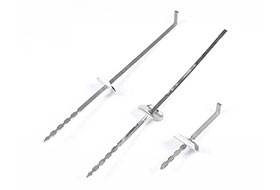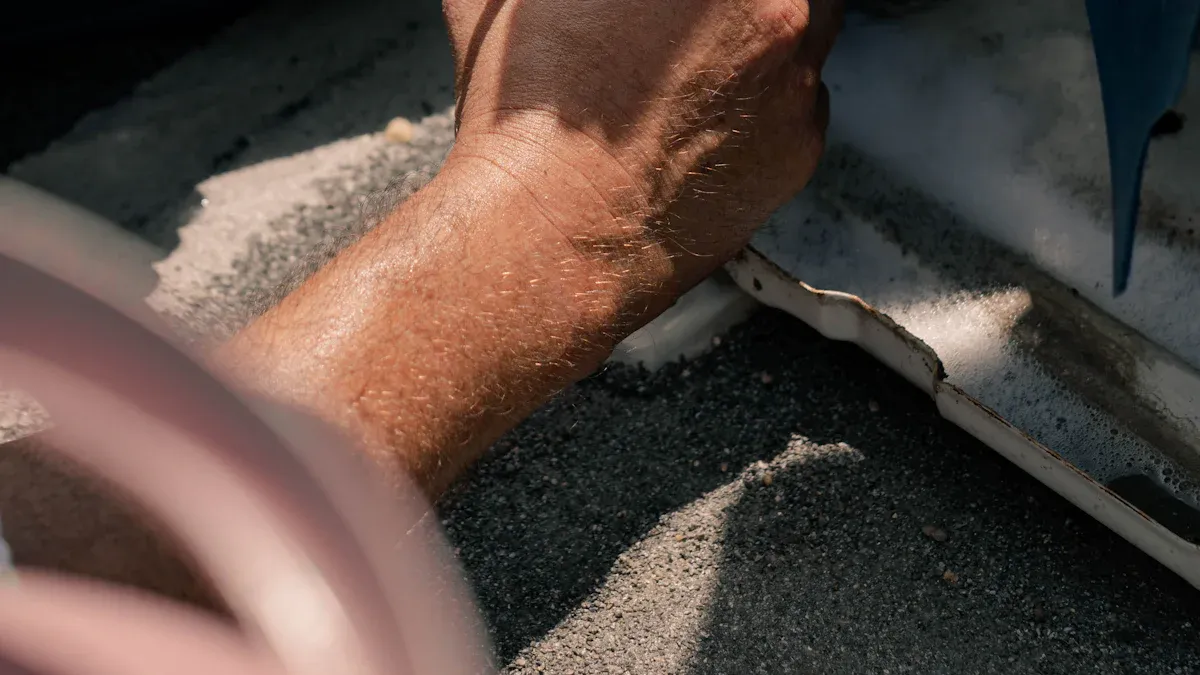Views: 0 Author: Site Editor Publish Time: 2025-07-24 Origin: Site










Ceramic refractory anchors keep refractory linings in place inside hot equipment. These anchors stop the lining from moving or breaking when the temperature changes fast. Ceramic refractory anchors hold the refractory materials tightly, so the structure stays safe and strong. Many industries use ceramic refractory anchors to stop expensive damage to their refractory systems.
Ceramic refractory anchors keep heat-proof linings in place inside hot machines. This stops damage and keeps the machines safe.
These anchors join the lining to the metal shell. They spread out the weight. They let the lining move a little. This helps stop cracks when things get hot or cold.
Anchors are made from tough ceramic materials. They handle heat, chemicals, and wear better than metal. They last longer in hard places.
Picking the right anchor shape is important. Putting them in with the right space, line, and depth helps the lining stay strong. It also helps it last longer.
Using ceramic refractory anchors means fewer repairs. It saves energy. It keeps workers safe by making machines work well.

Ceramic refractory anchors are special parts used in hot machines. These anchors keep the refractory lining from moving. The lining protects the machine from heat and damage. Refractory anchors stop the lining from falling when it gets hot or cools fast. They help the lining stay strong for a long time. Many factories use ceramic refractory anchors because they can handle heat. They do not melt or break easily.
Refractory anchors come in many shapes and sizes. Some look like pins. Others have a Y or V shape. Each type fits a certain lining or machine. The anchors lock the refractory material to the metal shell. This keeps the lining steady and helps it last longer.
Note: Ceramic refractory anchors do not let heat pass through easily. This helps keep the outside of the machine cooler and safer.
Factories use refractory anchors in many hot machines. Some places are:
Furnaces in steel plants
Kilns in cement factories
Boilers in power stations
Incinerators for waste treatment
These anchors are important anywhere a strong, heat-proof lining is needed. Workers put in refractory anchors before the main lining. The anchors make sure the lining stays put, even when the machine heats up or cools down fast. Without these anchors, the lining could crack or fall off. This would cost a lot to fix.
Ceramic refractory anchors help protect the machine and the workers. They make sure the refractory system works well and lasts a long time.
Refractory anchors help hold the refractory lining in place. These anchors connect the lining to the metal shell. When workers put in refractory anchors, they make a strong link between the lining and the equipment. This link keeps the lining from moving or falling when the machine is running.
The support system works in a few ways:
The anchors hold the refractory material firmly.
They spread out the weight of the lining.
They stop the lining from drooping or breaking.
Factories use different anchor shapes for each machine. Some anchors look like pins. Others have a Y or V shape. Each shape helps the anchor hold the lining well. Picking the right anchor shape stops weak spots from forming.
Tip: Putting refractory anchors in the right spots gives better support and helps the lining last longer.
Hot machines heat up and cool down many times. This is called thermal cycling. When this happens, the refractory lining gets bigger and smaller. These changes can cause stress inside the lining.
Refractory anchors help control this stress. They let the lining move a little without breaking. The anchors keep the refractory in place, even when the temperature changes fast. This lowers the chance of cracks or holes in the lining.
Thermal stress can hurt the lining if the anchors are not strong. Factories pick ceramic refractory anchors because they can take the heat and do not bend easily. These anchors keep the lining steady, even after many heating and cooling cycles.
Note: Using enough of the right refractory anchors helps stop expensive repairs and keeps machines safe.
Ceramic anchors are made from materials that handle high heat. These materials do not melt or break fast. Most ceramic anchors have alumina, silica, or other minerals. These minerals make the anchors strong and help them last longer in hot machines.
Ceramic anchors do not get damaged by gases or dust in furnaces. They do not rust like metal. This is why many factories use them. How well these anchors work depends on how they are made. Workers shape the ceramic, heat it in a kiln, and cool it slowly. This makes the anchor hard and strong.
Note: The materials for refractory anchors must match the heat and chemicals inside the machine. Picking the right ceramic helps the anchor work well.
Factories pick different anchor shapes for different jobs. Each shape holds the refractory lining in its own way. Some common shapes are:
Y-shaped anchors: These spread out force and hold thick linings.
V-shaped anchors: These work in thin linings and help stop cracks.
Pin anchors: These look like rods and support light linings.
The anchor’s shape changes how well it holds the lining. Some factories use a table to help choose the best anchor for each job.
| Anchor Shape | Best Use | Lining Thickness |
|---|---|---|
| Y-shape | Heavy-duty support | Thick |
| V-shape | Crack prevention | Thin |
| Pin | Simple support | Light |
Picking the right anchor shape helps the refractory lining stay strong and safe.

Workers use a few ways to put refractory anchors in hot machines. The main ways are welding and using bolts or screws. Each way has its own steps and safety rules.
Welding: Workers weld metal studs or holders to the steel shell. Then, they put the ceramic anchor on the welded part. Welding makes a strong hold. It keeps the anchor steady when the machine heats up or cools down.
Mechanical Fastening: Some systems use bolts, clips, or screws to hold the anchors. This way is good if welding cannot be done. It also helps if workers need to take out the anchors later.
Safety Considerations: Workers must wear gloves, goggles, and special clothes. Hot tools and sharp parts can hurt people. Safety lessons help stop accidents during the job.
Tip: Always look at the anchor and shell for damage before starting.
Putting refractory anchors in the right way is very important. Good work helps the lining last longer and not break early.
Spacing: Put anchors at even spaces. Too many anchors can make the lining weak. Too few can let it sag or crack.
Alignment: Make sure each anchor faces the right way. If not, weak spots can form.
Depth: Set anchors at the right depth in the lining. If too shallow, they may not hold. If too deep, they can cause stress.
Inspection: Check each anchor after putting it in. Look for cracks, loose parts, or bad welding.
| Step | What to Check |
|---|---|
| Spacing | Even distance between anchors |
| Alignment | Anchors face the right way |
| Depth | Anchors set at proper depth |
| Inspection | No cracks or loose anchors |
Note: Careful work with refractory anchors keeps machines safe and saves money on repairs.
High-temperature machines have many problems. Furnaces and kilns get hot and cool down a lot. These changes can make the lining inside crack or break. Ceramic refractory anchors help stop this from happening. They keep the refractory lining tight against the metal shell. This support stops the lining from moving or drooping when it gets hot or cold.
When the lining stays put, it keeps heat inside. This helps the machine work well and saves energy. If the lining breaks, hot gases can leak out and hurt the machine. Workers could also be in danger. Using ceramic refractory anchors lowers the chance of lining problems. This means less fixing and less time when the machine is off.
Note: Good anchors keep the insulation strong. They help stop heat from getting outside the machine.
Ceramic refractory anchors help machines work better and last longer. These anchors can take heat, chemicals, and wear. They do not rust or fall apart fast. Because of this, the refractory lining stays good for a long time.
A strong anchor system keeps the lining flat and smooth. This helps the machine keep the same temperature. It also keeps the metal shell safe from harm. Over time, this makes the machine safer and costs less money.
Factories that use ceramic refractory anchors get many good things:
Equipment lasts longer
Fewer times to stop for repairs
Workers are safer
Machines use less energy
| Benefit | Result |
|---|---|
| Strong lining support | Less cracking or sagging |
| Good insulation | Lower heat loss |
| Durable anchors | Fewer replacements needed |
Ceramic refractory anchors help high-temperature machines stay safe, work well, and last a long time.
Ceramic refractory anchors are very important for holding refractory linings in place. They help machines work safely and last longer when it gets really hot.
These anchors hold the lining steady, stop cracks, and keep heat from escaping.
Picking good anchors and putting them in right makes machines work better.
Remember: Using the right anchors keeps machines safe and helps save money in the long run.
Ceramic anchors can handle very high heat. They do not rust like metal anchors. They last longer in tough places. Metal anchors might melt or get damaged in hot spots. Factories pick ceramic anchors because they are safer and last longer.
Workers need to check the anchors every time there is big maintenance. Checking often helps find cracks or loose parts early. Finding problems soon keeps the equipment safe and working well.
Tip: Most ceramic anchors break or get weak when taken out. Factories should always use new anchors each time. Using old anchors again can make the lining fail or cause safety problems.
| Shape | Best Use |
|---|---|
| Y-shape | Thick linings |
| V-shape | Thin linings |
| Pin | Light linings |
Each shape holds the lining in its own way. Factories choose the shape that fits the job best.
